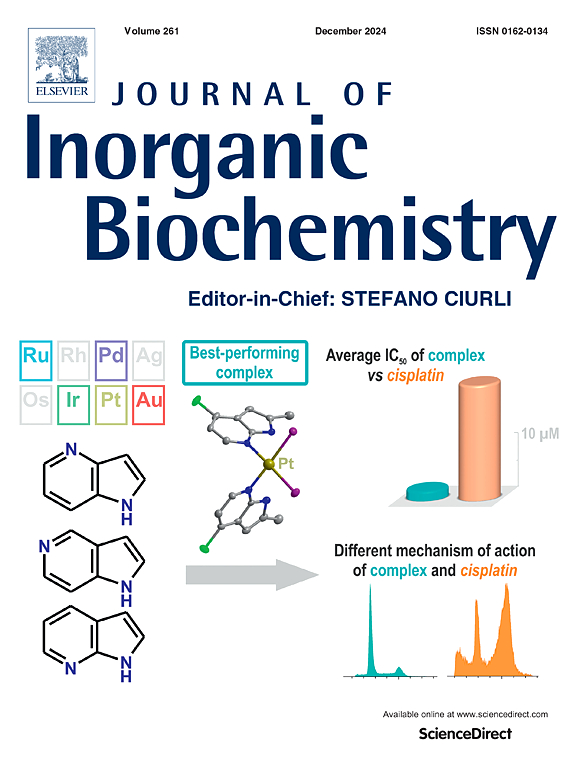Exploring the anticancer properties of indenyl and allyl palladates through their interaction with nucleic acids
IF 3.2
2区 化学
Q2 BIOCHEMISTRY & MOLECULAR BIOLOGY
引用次数: 0
Abstract
In this work, we analyse the mechanistic features of the interaction of indenyl (1-Ind) and allyl (2-All) palladates with nucleic acids (NAs) such as DNA (natural, poly(dA)-poly(dT) and poly(dG)-poly(dC)), RNA (in double and triple helices) and non-canonical structures of DNA (G-quadruplex and i-motif). Spectrophotometric titrations under different temperature and salt content conditions, viscosimetric experiments, fluorescent intercalator displacement (FID) tests together with theoretical Density Functional Theory (DFT)/Docking calculations are used to enlighten the complicated features of the interaction. The binding occurs in the grooves of the polynucleotides and is dominated by the geometrical features of the NA. A strong affinity for RNA double helix is present, together with interesting binding signatures to G-quadruplex and i-motif. The indenyl moiety plays a role and the binding is tighter (1-Ind > 2-All) for all NA systems. However, it is 2-All that, interestingly, shows the more striking differences in changing from one NA to another. The formation of covalent adducts and other mechanistic features are also discussed.

通过与核酸的相互作用,探索芳香酸酯的抗癌特性
在这项工作中,我们分析了独立基(1-Ind)和烯丙基(2-All)钯酸盐与核酸(NAs)的相互作用的机制特征,如DNA(天然的,聚(dA)-聚(dT)和聚(dG)-聚(dC)), RNA(双螺旋和三重螺旋)和非规范结构的DNA (g -四重体和i-motif)。通过不同温度和盐含量条件下的分光光度滴定、粘度测定实验、荧光插层置换(FID)实验以及密度泛函理论(DFT)/对接计算,揭示了相互作用的复杂特征。结合发生在多核苷酸的凹槽中,并受NA的几何特征支配。它对RNA双螺旋结构具有很强的亲和力,并与g -四重体和i-motif具有有趣的结合特征。独立基部分起作用,结合更紧密(1-Ind >;2-All)适用于所有NA系统。然而,它是2,有趣的是,所有这些都显示了从一个NA到另一个NA变化的更显著的差异。还讨论了共价加合物的形成及其机理。
本文章由计算机程序翻译,如有差异,请以英文原文为准。
求助全文
约1分钟内获得全文
求助全文
来源期刊

Journal of Inorganic Biochemistry
生物-生化与分子生物学
CiteScore
7.00
自引率
10.30%
发文量
336
审稿时长
41 days
期刊介绍:
The Journal of Inorganic Biochemistry is an established international forum for research in all aspects of Biological Inorganic Chemistry. Original papers of a high scientific level are published in the form of Articles (full length papers), Short Communications, Focused Reviews and Bioinorganic Methods. Topics include: the chemistry, structure and function of metalloenzymes; the interaction of inorganic ions and molecules with proteins and nucleic acids; the synthesis and properties of coordination complexes of biological interest including both structural and functional model systems; the function of metal- containing systems in the regulation of gene expression; the role of metals in medicine; the application of spectroscopic methods to determine the structure of metallobiomolecules; the preparation and characterization of metal-based biomaterials; and related systems. The emphasis of the Journal is on the structure and mechanism of action of metallobiomolecules.
 求助内容:
求助内容: 应助结果提醒方式:
应助结果提醒方式:


